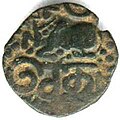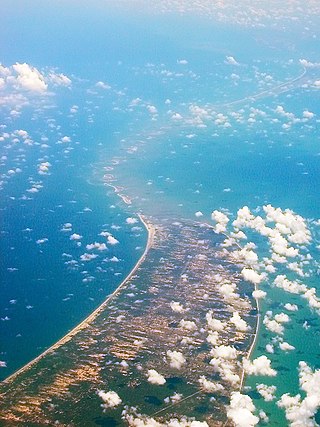
Adam's Bridge, also known as Rama's Bridge or Rama Setu, is a chain of natural limestone shoals between Pamban Island, also known as Rameswaram Island, off the southeastern coast of Tamil Nadu, India, and Mannar Island, off the northwestern coast of Sri Lanka. Geological evidence suggests that the bridge was formerly a land connection between India and Sri Lanka.

The Sri Lankan Rupee is the currency of Sri Lanka. It is subdivided into 100 cents, but cents are rarely seen in circulation due to their low value. It is issued by the Central Bank of Sri Lanka. The abbreviation Re (singular) and Rs (plural) is generally used, the World Bank suggests SL Rs as a fully disambiguating abbreviation for distinction from other currencies named "rupee".

The Coinage of India began anywhere between early 1st millennium BCE to the 6th century BCE, and consisted mainly of copper and silver coins in its initial stage. The coins of this period were Karshapanas or Pana. A variety of earliest Indian coins, however, unlike those circulated in West Asia, were stamped bars of metal, suggesting that the innovation of stamped currency was added to a pre-existing form of token currency which had already been present in the Janapadas and Mahajanapada kingdoms of the Early historic India. The kingdoms that minted their own coins included Gandhara, Kuntala, Kuru, Magadha, Panchala, Shakya, Surasena, Surashtra and Vidarbha etc.

The Jaffna kingdom, also known as Kingdom of Aryachakravarti, was a historical kingdom of what today is northern Sri Lanka. It came into existence around the town of Jaffna on the Jaffna peninsula and was traditionally thought to have been established after the invasion of Kalinga Magha from Kalinga in India. Established as a powerful force in the north, northeast and west of the island, it eventually became a tribute-paying feudatory of the Pandyan Empire in modern South India in 1258, gaining independence when the last Pandyan ruler of Madurai was defeated and expelled in 1323 by Malik Kafur, the army general of the Delhi Sultanate. For a brief period in the early to mid-14th century it was an ascendant power in the island of Sri Lanka, to which all regional kingdoms accepted subordination. However, the kingdom was overpowered by the rival Kotte kingdom around 1450 when it was invaded by Prince Sapumal under the orders of Parakramabahu VI.

The Arya Chakravarti dynasty were kings of the Jaffna Kingdom in Sri Lanka. The earliest Sri Lankan sources, between 1277 and 1283, mention a military leader of this name as a minister in the services of the Pandyan Empire; he raided the western Sri Lankan coast and took the politically significant relic of the Buddha's tooth from the Sinhalese capital city of Yapahuwa. Political and military leaders of the same family name left a number of inscriptions in the modern-day Tamil Nadu state, with dates ranging from 1272 to 1305, during the late Pandyan Empire. According to contemporary native literature, such as Cekaracecekaramalai, the family also claimed lineage from the Tamil Brahmins of the prominent Hindu pilgrimage temple of Rameswaram in the modern Ramanathapuram District of India. They ruled the Jaffna kingdom from the 13th until the 17th century, when the last of the dynasty, Cankili II, was ousted by the Portuguese.
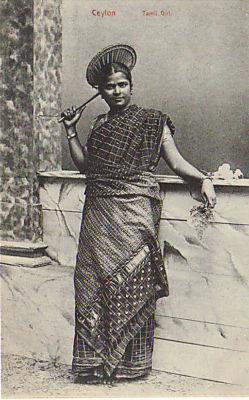
Sri Lankan Tamils, also known as Ceylon Tamils or Eelam Tamils, are Tamils native to the South Asian island state of Sri Lanka. Today, they constitute a majority in the Northern Province, form the plurality in the Eastern Province and are in the minority throughout the rest of the country. 70% of Sri Lankan Tamils in Sri Lanka live in the Northern and Eastern provinces.
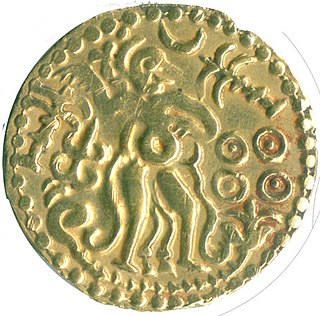
Kahavanu is a medieval currency from Sri Lanka. The coinage appears to have been initiated shortly before Rajaraja Chola invaded Lanka in 990 AD, and struck through the period when the Cholas dominated the island (1017-1070), and continued by closely similar coins struck for Vijayabahu (1055-1110) after he re-established Sinhala independence in 1070. Like other Lankan coins from around the 11th Century, no date is indicated. It is not certain whether the Kahavanu was introduced at Ruhuna, the region in the south of the island to which the Sinhala court had been obliged to move as a result of Rajaraja's conquests.
Kayts, is one of the important small island off the coast of the Jaffna Peninsula in northern Sri Lanka. There are a number of other villages within the Kayts Island such as Allaippiddi, Mankumpan, Velanai, Saravanai, Puliyankoodal, Suruvil, Naranthanai, Karampon and Melinchimunai.
Sri Lankan Tamil literature or Ceylon Tamil literature refers to Tamil literature produced in the current day country of Sri Lanka by various Tamil speaking communities such as the Sri Lankan Tamils, Indian Tamils of Sri Lanka and Sri Lankan Muslims. The earliest extant records survived from the Sangam age academies and continued in the medieval era in the courts of the Jaffna kingdom until modern times. The destruction of the Saraswathy Mahal library of Nallur and the burning of Jaffna library led to the loss of a large tract of Sri Lankan Tamil literature, although much survives through oral traditions and the unearthing and preservation of palm-leaf manuscripts, copper plate inscriptions & stone inscriptions.
Most of the pre-modern coinage used in Sri Lanka or coins used in pre-Christian Sri Lanka can be categorised as punch-marked coins, tree and swastika coins, elephant and swastika coins and Lakshmi plaques.

There are literary, archaeological, epigraphic and numismatic sources of ancient Tamil history. The foremost among these sources is the Sangam literature, generally dated to 5th century BCE to 3rd century CE. The poems in Sangam literature contain vivid descriptions of the different aspects of life and society in Tamilakam during this age; scholars agree that, for the most part, these are reliable accounts. Greek and Roman literature, around the dawn of the Christian era, give details of the maritime trade between Tamilakam and the Roman empire, including the names and locations of many ports on both coasts of the Tamil country.
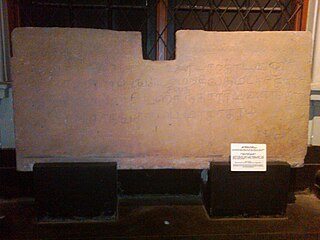
The Kotagama inscription found in Kegalle District in Sri Lanka is a record of victory left by the Aryacakravarti kings of the Jaffna Kingdom in western Sri Lanka. The inscription reads;
"The women-folks of lords of Anurai who did not submit to Ariyan of Cinkainakar of foaming and resounding waters shed tears from eyes that glinted like spears and performed the rites of pouring water with gingerly seed from the bejeweled lotus like hands."

The flag of the Jaffna kingdom of the Aryacakravarti line of kings of Jaffna kingdom in northern Sri Lanka consisted of the couchant bull, the silver crescent moon with a golden sun. The single sacred conch shell, which spiral open to the right, and in the centre above the sacred bull, is a white parasol with golden tassels and white pearls. The color of the Royal Flag is saffron. The flag symbols are similar to number of flags found in India especially belonging to the Eastern Ganga dynasty. The Setu coins minted by the Aryacakravarti kings also have a similar symbol.

The Vanni chieftaincies or Vanni tribes was a region between Anuradhapura and Jaffna, but also extending to along the eastern coast to Panama and Yala, during the Transitional and Kandyan periods of Sri Lanka. The heavily forested land was a collection of chieftaincies of principalities that were a collective buffer zone between the Jaffna Kingdom, in the north of Sri Lanka, and the Sinhalese kingdoms in the south. Traditionally the forest regions were ruled by Vedda rulers. Later on, the emergence of these chieftaincies was a direct result of the breakdown of central authority and the collapse of the Kingdom of Polonnaruwa in the 13th century, as well as the establishment of the Jaffna Kingdom in the Jaffna Peninsula. Control of this area was taken over by dispossessed Sinhalese nobles and chiefs of the South Indian military of Māgha of Kalinga (1215–1236), whose 1215 invasion of Polonnaruwa led to the kingdom's downfall. Sinhalese chieftaincies would lay on the northern border of the Sinhalese kingdom while the Tamil chieftaincies would border the Jaffna Kingdom and the remoter areas of the eastern coast, north western coast outside of the control of either kingdom.
Bhuvanekabahu VI of Kotte, also known as Sapumal Kumaraya or Yudistra Darma Dorai and Chempaka Perumal, was an adopted son of Parakramabahu VI. His principal achievement was the conquest of Jaffna Kingdom, a historical kingdom of what today is northern Sri Lanka, in 1447 or 1450. Although he was victorious and ruled, he was unable to prevent Kanakasooriya Cinkaiariyan and his two son's return from Madurai with mercenaries to wrest the Jaffna Kingdom from Kotte's over lordship. Bhuvanaikabahu was apparently summoned south after the demise of his adopted father. He then ruled for 17 years. According to Rajavaliya, he killed the grandson of Parakrama Bahu VI, namely Vira Parakrama Bahu or Jaya Bahu.

The earliest coins of the Pandyan Kingdom were copper squares and were struck with a die. The coins were with five distinct images on one side, often an image of an elephant on that side and a stylised fish on the other, seen typically in the coins found around Korkai, their ancient capital and in Northern Lanka. These rectangular coins of the early Pandyans also featured the Nandi bull and contain Chakrams. The "Chakram" consists of two lines forming an acute angle, the apex being uppermost; with are two crossed lines parallel to the sides of the angle which they join. All four lines end at the bottom of the symbol on the same level. This symbol but with the outer lines somewhat shorter than the inner is used by certain Tamils in the Anuradhapura District as a brand-mark for cattle; a variant with the outer lines continued beyond the apex in the form of a loop or of a pair of pincers occurs in the Northern Province and represents a makara. The symbol or brandmark on the coin being a conventional fish, the well-known Pandyans badge.

The Sethupathis are a Tamil clan of the Maravar community native to the Ramanathapuram and Sivaganga district of Tamil Nadu, India. They were from the 12th century considered independent kings in 16th century who ruled the Ramnad kingdom, also known as Maravar country. The male rulers of Ramnathapuram also bore the title of "Sethupathi" or "protector of the bridge", the bridge here referring to the legendary sacred Rama's Bridge, while female rulers bore the title "Nachiyar". Among the 72 poligars of the region, the Sethupathi stood first. This special position was conferred not based upon the revenue that his kingdom generated but because of his military prowess. Back in the beginning of the 18th century, the Sethupathi ruler could mobilize a considerable army, about 30,000 to 40,000 strong at short notice.
The Tissanayagam family(Mathakal), sometimes also spelled Tissainayagam, is a Jaffna Tamil family descended from Tissanayaka Mudali of Mannanpulam Mathakal. Tissanayaka Mudali (circa 1730) was a Tamil chieftain who lived during Dutch times (1658–1798).
When to date the start of the history of the Jaffna kingdom is debated among historians.
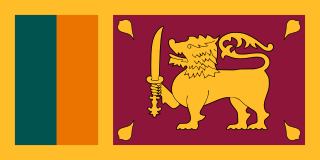
This is a bibliography of works on Sri Lanka.

